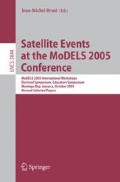Abstract
As the Unified Modeling Language (UML) has by now seen widespread and successful use in the software industry and academia alike, it has also found its way into many computer science curricula. An outstanding advantage of teaching UML is that it enables an illustration of many crucial concepts of software engineering, far beyond its concrete notation. Most important among these concepts is that of abstraction. We present a course design which demonstrates the use of UML as a vehicle for teaching such core concepts of software engineering. Multimedia elements and tools help to efficiently convey the course’s message to the students.
Access this chapter
Tax calculation will be finalised at checkout
Purchases are for personal use only
Preview
Unable to display preview. Download preview PDF.
References
Alfert, K., Doberkat, E.-E., Engels, G., Lohmann, M., Magenheim, J., Schürr, A.: MuSoft: Multimedia in der Softwaretechnik. In: Software Engineering im Unterricht der Hochschulen, pp. 70–80. dpunkt Verlag (2003)
Ambler, S.W.: The Elements of UML Style. Cambridge University Press, New York (2002)
Bruce, K.: Thoughts on computer science education. ACM Computing Surveys 28(4es), 93 (1996)
Burton, P.J., Bruhn, R.E.: Using UML to facilitate the teaching of object-oriented systems analysis and design. Journal of Computing Sciences in Colleges 19(3), 278–290 (2004)
Gehrke, M., Giese, H., Nickel, U.A., Niere, J., Tichy, M., Wadsack, J.P., Zündorf, A.: Reporting about industrial strength software engineering courses for undergraduates. In: ICSE 2002: Proceedings of the 24th International Conference on Software Engineering, pp. 395–405. ACM Press, New York (2002)
Hoare, C.A.R.: Notes on data structuring. In: Dahl, O.-J., Dijkstra, E.W., Hoare, C.A.R. (eds.) Structured Programming, pp. 83–174. Academic Press, London (1972)
Jacobson, I., Booch, G., Rumbaugh, J.: The Unified Software Development Process. Addison-Wesley Longman Publishing Co., Inc., Boston (1999)
Kramer, J.: Abstraction - is it teachable? ’The Devil is in the Detail’. In: CSEE&T, p. 32. IEEE Computer Society Press, Los Alamitos (2003)
Kuehne, T.: What is a model? In: Bezivin, J., Heckel, R. (eds.) Language Engineering for Model-Driven Software Development. Dagstuhl Seminar Proceedings. Internationales Begegnungs- und Forschungszentrum (IBFI), vol. 04101, Schloss Dagstuhl, Germany (2005), http://drops.dagstuhl.de/opus/volltexte/2005/23
Object Management Group. UML 2.0 Superstructure- Public Specification-. OMG document formal/05-07-04 (August 2005)
The Joint Task Force on Computing Curricula. Computing curricula 2001 computer science - final report. Association for Computing Machinery. IEEE Computer Society, Los Alamitos (2001), http://www.sigcse.org/cc2001/
The Joint Task Force on Computing Curricula. In: Software engineering 2004 curriculum guidelines for undergraduate degree programs in software engineering. A volume of the computing curricula series (2004), http://sites.computer.org/ccse/
Pleumann, J.: Erfahrungen mit dem multimedialen, didaktischen Modellierungswerkzeug DAVE. In: Engels, G., Seehusen, S. (eds.) DeLFI 2004: Die e-Learning Fachtagung Informatik, Tagung der Fachgruppe e-Learning der Gesellschaft für Informatik e.V (GI), Paderborn, GI, September 6-8. LNI, vol. 52, pp. 55–66 (2004)
Woehr, J.J.: An interview with Donald Knuth. Dr. Dobb’s Journal of Software Tools 21(4) (1996)
Author information
Authors and Affiliations
Editor information
Editors and Affiliations
Rights and permissions
Copyright information
© 2006 Springer-Verlag Berlin Heidelberg
About this paper
Cite this paper
Engels, G., Hausmann, J.H., Lohmann, M., Sauer, S. (2006). Teaching UML Is Teaching Software Engineering Is Teaching Abstraction. In: Bruel, JM. (eds) Satellite Events at the MoDELS 2005 Conference. MODELS 2005. Lecture Notes in Computer Science, vol 3844. Springer, Berlin, Heidelberg. https://doi.org/10.1007/11663430_32
Download citation
DOI: https://doi.org/10.1007/11663430_32
Publisher Name: Springer, Berlin, Heidelberg
Print ISBN: 978-3-540-31780-7
Online ISBN: 978-3-540-31781-4
eBook Packages: Computer ScienceComputer Science (R0)

